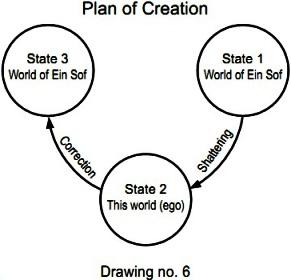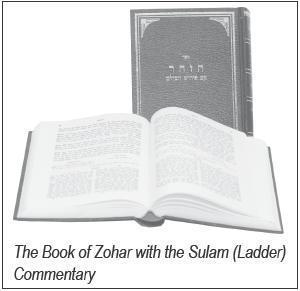Part II: The World Was Created for Me. Chapter 6: Outer Is Inner
All who fault, fault in their own defect
Babylonian Talmud, Kidushin 70b
It is no coincidence that we were made to perceive reality as divided into two parts—me and what is outside of me. If our perception were only internal we would never be able to rise above our egos toward the quality of love and giving. We would be wedged in one place, “chasing our own tails.”
Here is an example to clarify what this means. Each of us has a certain amount of self-centered tendencies such as desires for domination or pride. When we examine ourselves, we don’t really notice them. But when we see others acting out of a craving to dominate or to boast, for the most part it annoys us.
We have been preordained with hatred and repulsion of others to allow us not to be biased and to define our attitude toward these tendencies in a wise and critical manner. Like a strict and perceptive judge, our ego helps us examine the evil that appears before us in others, to judge it meticulously, profoundly, and in great detail.
Our initial external perception opens our eyes and allows us to detect bad things outside of us. Afterwards, we realize that in truth, it is all within us. It is said that “All who fault, fault in their own defect.” However, we are destined to discover that it’s not that “he is overbearing” and “she is a snob,” but that it is we who are seeing them this way because of our own spoiled desires.
_____________________________________________________________
The Creator’s desired goal for the creation He had created is to bestow upon His creatures so they will know His truthfulness and greatness, and receive all the delight and pleasure He had prepared for them.
Baal HaSulam, “Introduction to The Book of Zohar,” Item 39
___________________________
As stated above, it is desire that shapes our perception of reality. Now we will try to understand what parts make up the desire, why we were created specifically as we are, and how we can change our reality for the better.
Along the way, we will discover why such emotions as hatred and love toward others appear in us, what causes us to be glad when someone else is suffering, and why we are envious when the neighbor buys a new car.
Question: if the purpose of Creation is to be delighted, why does it seem that matters are constantly getting worse? The Book of Zohar explains that in truth, we exist in a perfect system that was created by the Creator. The whole of the substance of Creation is the will to receive, and the perfect system is actually the comprehensive will that was created. This will is also called “the general soul” or “the soul of Adam HaRishon.” However, the Creator broke the general soul into many pieces, and in each of us there is only a tiny fraction of the general soul.
Prior to the breaking, we all felt like organs of a single body in this system. Everything was perfect and unbounded; hence, at that time, the system was called “the world of Ein Sof [infinity].” In the world of Ein Sof, all parts of the system are connected with love and are filled with light. However, the Creator placed 125 “filters” on this system, which conceal the worlds so now we cannot sense that there is any light there.
It is like a beautiful picture covered with a stained nylon sheet, on top of which there is another stained sheet, and another one, so the original picture becomes increasingly hidden.
We are on the outermost layer and have no sense whatsoever of the previous layers, hence the connection between us is completely distorted. Instead of feeling the love that connects us in the world of Ein Sof, there is hatred and repulsion among us. We do not feel the comprehensive connection between us; instead, we are separated and detached.
The Creator wanted us to return to the good and enlightened state by ourselves, to the world of Ein Sof. This is the program of the evolution of Creation, which divides into three stages:
-
 Stage One: the initial state (the world of Ein Sof);
Stage One: the initial state (the world of Ein Sof); - Stage Two: the broken state (this world);
- And Stage Three: the perfect state, which we must create by ourselves (returning to the world of Ein Sof).
It is quite similar to the way we behave with children. We take a picture, cut it into pieces, then let them put the pieces back together. The reassembly process develops the child.
As a result of the shattering, the will (known as Kli[vessel]) of every person was divided into two main parts: internal Kelim [vessels], known as “root,” “soul,” and “body,” and external Kelim, known as “clothing” and “palace.” I perceive my inner Kelim as “me,” therefore I care for them, and I perceive the external Kelim as alien, not my own. The inner Kelim and the outer Kelim contradict each other, so the more I love my inner Kelim, the more I hate my outer Kelim.
There is a boundary between those two types of Kelim—the border of the shattering. It is a kind of partition that causes me to look outward only in a mindset of “What can I receive from there to improve my situation? What does that give me?” It compels me to always relate to others egoistically, desiring to exploit them.
I always evaluate my situation by the difference between myself and the rest of the world. Hence, as surprising and as odd as it may sound, the worse it is for the world, the better it is for me—provided it does not put my personal safety in any danger.
I cannot tolerate fulfillment in the external Kelim. I cannot remain indifferent toward another or behave as though I do not care about him or her. When another person succeeds, it is very painful to me, it really destroys me. I constantly compare.
If, for instance, I earn $100,000 a year, and the people around me earn $50,000, I feel great satisfaction. But if someone earns $200,000 a year, I feel great disappointment. I cannot rid myself of this thought and settle for what I have because it is so important to me that others have less than me.
We cannot simply ignore those external Kelim because we feel them as belonging to us. If there were no connection between us, it would be another story. However, the shattering created a negative connection between us so that even if we did nothing bad to one another, the force of the shattering makes us de facto enemies.
_____________________________________________________________
But the equal side in all the people of the world is that each of us stands ready to abuse and exploit all the people for his own private benefit with every means possible, without taking into any consideration that he is going to build himself on the ruin of his friend.
Baal HaSulam, “Peace in the World”
___________________________
Understanding how these matters work is extremely important because it serves as a means for change, a lever for development. Let us examine another example that, precisely because it is extreme, helps us understand the issue more precisely.
All of humanity’s villains acted on the same inner drive to expand the gap between their own internal Kelim and their external Kelim. Nazi Germany, for instance, could not settle for realizing the great human potential of the German people to create a thriving country. Instead, a drive appeared in it to be superior to others, to govern them, to destroy them. Only then would it feel that it was truly great.
Human egoism feels that killing other people, exploiting them, and dominating them is pleasurable for it. This is the result of the shattering—man is hurting himself, his own external Kelim, but he doesn’t know it. When we find out that all the evil we have been trying to inflict on others was really inflicted on ourselves, will experience immense disillusionment and pain. Yet, it is precisely this pain and disillusionment that will help us carry out the actual correction.
We are unaccustomed to discussing these matters and we tend to hide them, but where it is distinctly visible is in politics. We even found a respectable name to this world of lies—“diplomacy.” Each side strives to dominate the other, but for lack of other choices, signs an alliance with the other side.
In human society, we have built many systems to allow us to live with minimal friction between the inner Kelim and outer Kelim of each. We understand that otherwise we will all be harmed. We have established Social Security, welfare systems, and charities because we are all terrified that tomorrow we, too, will be in that state of need. Hence, we prepare the cure ahead of the blow.
Hatred between inner and outer Kelim is a human phenomenon that doesn’t exist in the animal kingdom. When a lion eats a zebra, it doesn’t hate it, and the zebra doesn’t hate the lion. The lion regards the zebra as food and the zebra tries not to be eaten. But there is no hatred between them. Nature governs both of them perfectly.
If there were no connections between us, we would not be able to discover the reason for what is bad in our lives. However, because we are discovering that the connections between us are bad, we can then turn them into good.
Let us examine the current state of humanity. In the past, ties among countries barely existed. Each country was connected only to a few other countries. When we were far from each other, there was not much contact, hence the evil was not so evident. But as the world became more globalized, everyone became connected, affecting everyone else. Suddenly, there was nowhere to run. We do not have another earth, hence the hatred between us is surfacing. Yet, it is precisely this hatred that will compel us to correct our relationships.
_____________________________________________________________
Even though we see everything as actually being in front of us, every reasonable person knows for certain that all that we see is only within our own brains.
Baal HaSulam, “Preface to The Book of Zohar”
___________________________
Now that the picture of our relations with others has been made a little clearer, we can move on. As we said above, the force that divides our picture of reality into two parts—internal and external—is the force of the shattering. After the shattering, part of our desires (our outer Kelim, “clothing” and “palace”) were no longer sensed as our own. It is like a person who received an anesthetic to the leg, and while his leg was being amputated, he laughed and talked, behaving as though nothing was happening to him because he felt nothing.
In these parts of the will, “clothing” and “hall,” we actually feel all that is not us, meaning the outside world. Around us are people, processes unfolding, and the entire world when in fact, they are all parts of our own desire.
We are living in a long feature film in which our desires our projected before our eyes, and what determines the image we see each moment in the film is the Reshimot [recollections]. As mentioned in Chapter 2, Reshimot are information bits that define our personal plan of development.
Let us review what we have said before to restore some order. Reality consists of three elements: the light, the power of love and giving (the Creator), the will to receive (the creature), and the Reshimot(the creature’s plan of development). First, the Creator created the creature, meaning a desire to receive pleasure. Then the Creator broke the desire into an inner part (root, soul, body) and an outer part (clothing, palace), and created in it an egoistic sensation of “me vs. the world.”
Within the desire is its development plan, which consists of Reshimot. Each such Reshimo [singular of Reshimot] constitutes a certain state that the creature must experience until it corrects the shattering—equalizes with the qualities of the Creator and realizes the purpose of Creation.
If we return to the film, what I see now is a realization of the Reshimo that I feel in the five parts of my desire, and there is nothing else but that.
Each moment, new Reshimot awaken in my desire and evoke new impressions in me, which immediately makes me see a different world. My whole life, the whole of reality are Reshimot that pass through me and become realized. The light affects me, my desire, through which the Reshimot begin to traverse in a chain as though in frames on celluloid film.
I feel that it is my life that I am living, but is it really me living it? If look back a few years, will I believe that it was really me? It seems as though some motion picture ran through me. Many people feel that way—that life passes through them as though in a dream, that it was not them doing and experiencing, but some projection, a film that was projected and they were playing their roles in it.
The Zohar explains that there is nothing but Reshimot, light, and desire. Each Reshimo that passes divides the desire into two—internal and external. We experience ourselves and something other, which seems to be outside of us—trees, sun, moon, people. We have children, we are at work, there is always us and something other. Why?
The sensation of reality as though it were divided into two allows us to recognize that besides us there is another force—the light, the Creator—which compels us to search for it.
_____________________________________________________________
All the worlds, Upper and lower, are included in man.
Baal HaSulam, “Introduction to the Preface to the Wisdom of Kabbalah,” Item 1
_____________________________________________________________
The Book of Zohar is hidden in the sense that people don’t know how to read and understand what is written in it because the key to reading it is in the perception of reality. The Zohar demands that we understand that the reality we perceive is happening within, not without.
Even the upper world, to which The Zohar is leading us, will be experienced within us. It is pointless to search for the outlet to the upper world beyond the horizon. Rather, it is only a change in our inner qualities.
The Zohar speaks of a reality that exists “above” what we feel at the moment, “above” time, space, and motion. This external reality that it describes and which appears to be outside of us is nowhere to be found. It is all within our will. All phenomena, sensations of the past, present, and future are depicted within it. History is merely a process that we picture as something that occurred sometime in the past, when in truth, there is no time at all, no motion, and all places are imaginary. There is only one place where everything occurs—the desire.
The natural course of things, the different parts of our desire (internal and external, me and others) collide with one another. The Book of Zohar assists us in correcting the connection between them, in joining them until they become one and we feel no difference between them. This is the longed-for change in our perception of reality.
This is how we discover the upper world, also known as “the next world.” It is not that we prepare ourselves here and subsequently reach some other place. Rather, the more we show love toward others instead of hatred, the more we begin to feel what is called “the upper world” or “the next world.” All the worlds are here in the connection between us and what currently seems to be outside of us, remote.
Desires that seem to us as others are divided into several circles with respect to our ego. In the closest circle are family, relatives and friends. In the next circle are people who help us and who benefit us by their existence, such as doctors. Then there are the people that we only want to use, to harm, but to keep them alive. And the farthest are the people that we truly hate and may even be prepared to kill.
Yet, they are all our own desires. When we reconnect them to ourselves, we will become the general soul that the Creator created and will return to the world of Ein Sof.
It is important to stress that the process of correcting the perception of reality is not meant to be carried out artificially. If my neighbor were to yell at me tomorrow, I would not reply with something like, “Relax, my friend. After all, we are all one will.” It is also not a simplistic shift of “inward instead of outward.”
Rather, it is a profound transformation, and to execute it we need The Book of Zohar to help us build that new perception within us, as well as the company of people who will support us in the correction process.
_____________________________________________________________
The most hidden is given to the wise at heart.
Zohar for All, Lech Lecha [Go Forth], Item 96
___________________________








